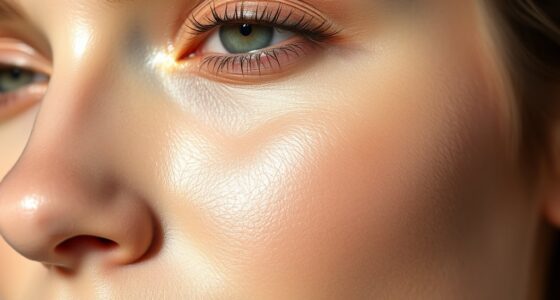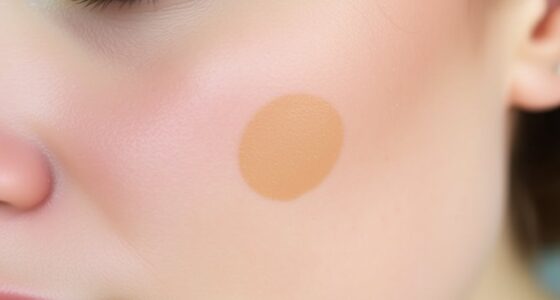To find your undertone, look at the veins on your wrist—if they appear blue or purple, you likely have a cool undertone. If they look green, warm undertones are more common. If it’s hard to tell or they seem to have a mix, you might have a neutral undertone. Knowing your undertone helps you choose flattering colors for makeup and clothes. Keep exploring, and you’ll discover even more ways to highlight your natural beauty.
Key Takeaways
- Examine your veins: blue/purple veins suggest cool undertones; green veins indicate warm undertones; mixed or difficult to tell may be neutral.
- Test jewelry: silver tends to flatter cool undertones, gold complements warm undertones, and both work well for neutral undertones.
- Observe skin’s reaction to sun: cool undertones often burn easily, warm undertones tan more easily; neutral may tan or burn variably.
- Hold a white cloth or piece of paper near your face: cool undertones look better with pure white, warm undertones with creamy or beige shades, neutral can go with both.
- Consider your overall skin appearance: pink or red hues indicate cool undertones; golden or peach hints suggest warm undertones; a balanced mix points to neutral undertones.

Understanding your undertone is essential for choosing the right makeup shades, clothing, and accessories that complement your natural complexion. Your skin tone variations play a significant role in determining whether you have warm, cool, or neutral undertones. Recognizing these subtle differences allows you to master makeup color matching and ensure everything from foundation to eyeshadow enhances your natural beauty. When you know your undertone, selecting colors that harmonize with your skin becomes much easier, making your overall look more polished and effortless. Additionally, knowing about floating on water can inspire your style choices, emphasizing lightness and fluidity that complement your skin tone beautifully.
Frequently Asked Questions
Can My Undertone Change Over Time?
Yes, your undertone can change over time due to factors like seasonal variations and aging. Your skin tone may appear warmer in summer and cooler in winter, which can influence your perceived undertone. Environmental factors, health, and lifestyle habits also play a role in shifting your skin’s hue. Regularly reassessing your undertone helps you choose the most flattering makeup and clothing, ensuring you look your best year-round.
How Does Skin Undertone Affect Makeup Choices?
Think of your skin undertone as the secret sauce in your makeup recipe. It guides you to choose perfect foundation shades that blend seamlessly and eyeshadow palettes that pop. When your undertone is warm, opt for earthy tones; for cool undertones, go for icy shades. Neutral undertones are versatile, allowing you to experiment freely. Knowing your undertone helps your makeup look natural and radiant, like it was made just for you.
Are Undertones the Same in Different Body Areas?
Undertones can vary across different areas of your body, so you might notice some area variation. While your overall undertone tends to be consistent, certain spots like your wrists or neck may show subtle differences. It’s important to check multiple areas to determine your undertone accuracy. This helps you choose makeup that truly complements your skin, ensuring your undertone consistency translates well across your entire face and body.
Can Lighting Influence How I Perceive My Undertone?
Like a painter’s brush, lighting effects can change how you see your undertone. Under warm light, your skin may appear more golden or peachy, while cool lighting can make it seem rosier or more muted. So yes, lighting influences your undertone perception, and it’s wise to view your complexion in natural daylight for the most accurate assessment. Always check your undertone in different lighting to get the full picture.
Is There a Quick Test to Determine My Undertone at Home?
Yes, there’s a quick at-home test you can try. Hold a piece of jewelry against your skin—gold usually complements warm undertones, while silver favors cool ones. Compare how these contrast with your skin color; if gold looks better, you likely have warm undertones, if silver is more flattering, you’re probably cool. Using a color wheel can also help identify which shades enhance your natural complexion.
Conclusion
Think of your undertone as a hidden river flowing beneath your skin, guiding your color choices like a gentle current. When you recognize its warm, cool, or neutral path, you reveal a world of harmony—like finding the perfect melody in a song. Trust your instinct to follow this subtle stream, and you’ll discover shades that resonate with your natural glow. Embrace your unique flow, and let your true colors shine effortlessly.









